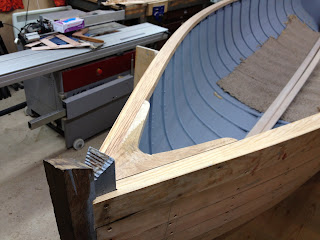Unfortunately I didn't take any photos when I constructed these Oars. They were a pleasure to design and make, but I didn't realise the effort, design and time that goes into them.
I received a lot of guidance from Julian Burns (now retired from Sail and Oar) who kindly explained the principles and construction of Oar making.
They are are built using English Ash; the Looms are laminated in two sections and glued using epoxy resin. The blades are then added before shaping. The length is determined by a number of factors; the beam of the boat, the freeboard (distance from the waterline to the top of the rubbing strake, plus the height to the rowlock) and more...
The transition of the loom to the blades is an elliptical section where strength is only needed in one plane thereby minimising weight. Inboard from the rowlocks the loom is left in the square to counterbalance the weight outboard.
This determined a length of 9'3" for the central rowing position and in time I will make some slightly shorter oars for the forward position as she was was designed as a two man skiff.































